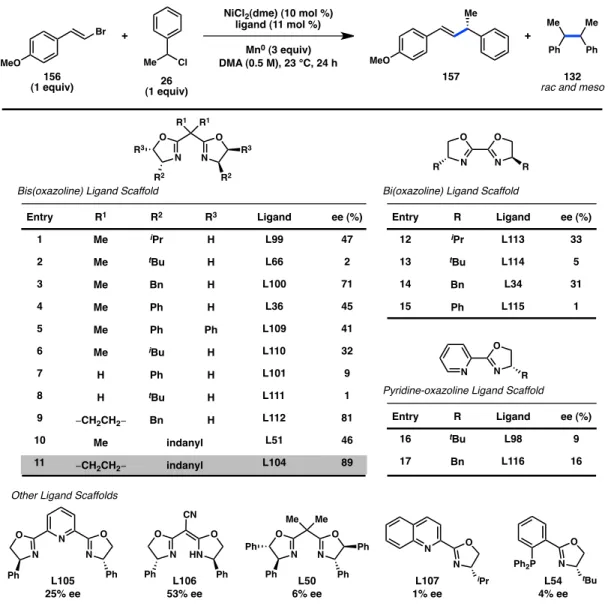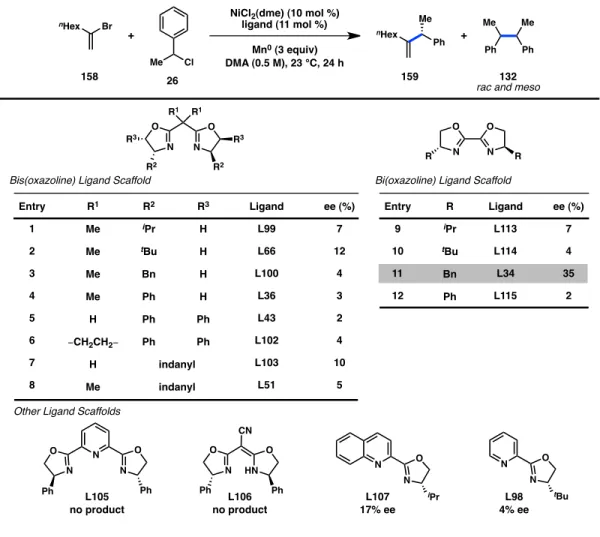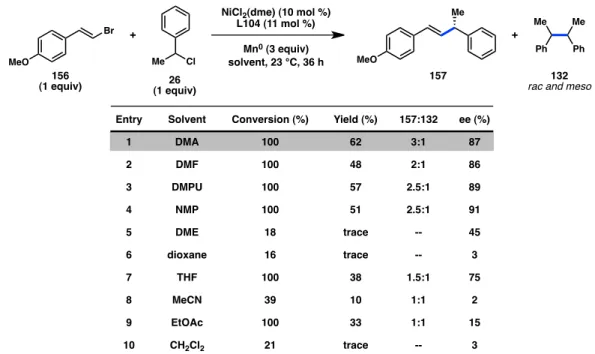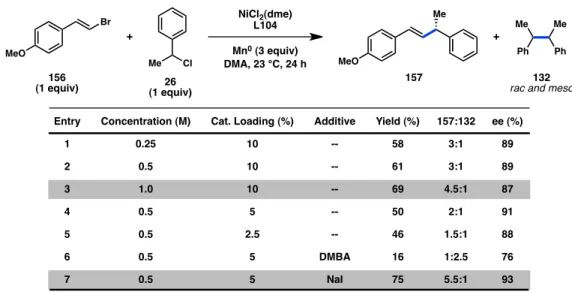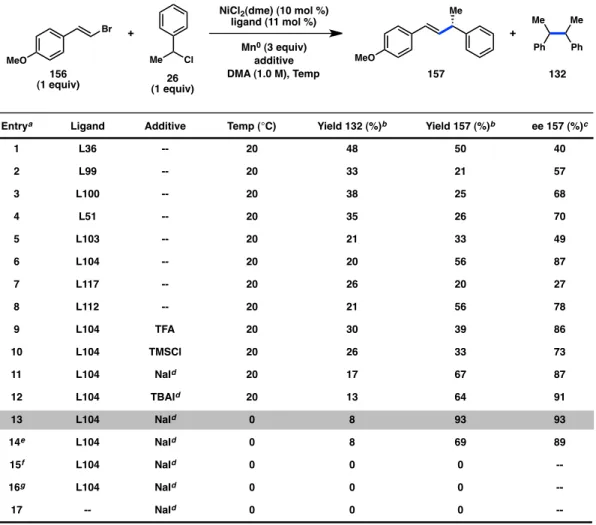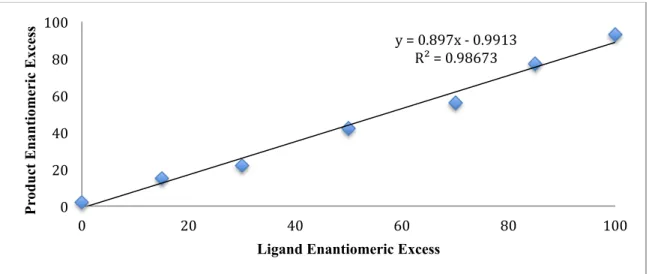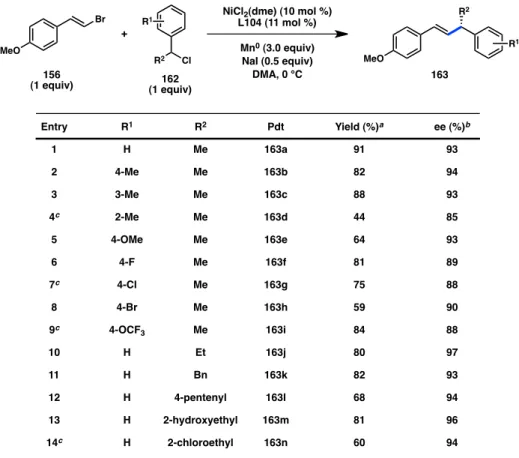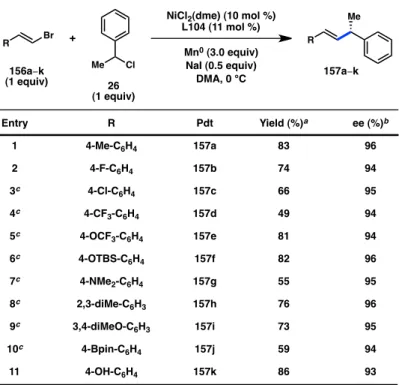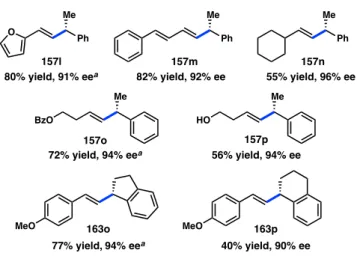Chapter 4
Nickel-Catalyzed Asymmetric Reductive Cross-Coupling Between Vinyl and Benzyl Electrophiles†
4.1 INTRODUCTION
Ni-catalyzed reductive cross-coupling reactions have recently emerged as direct methods for carbon–carbon bond formation between two organic electrophiles.1 In these reactions, Mn0 or Zn0 are typically employed as stoichiometric reductants to turn over a Ni catalyst. Improvements in ligand structure and mechanistic understanding have enabled the cross-coupling between a range of C(sp3)and C(sp2)electrophiles bearing a variety of functional groups.2, 3, 4 The ability to employ bench stable and readily available organic halides, without the need to pre-generate a reactive organometallic reagent, endows these reductive cross-coupling reactions with a practical advantage over many conventional cross-coupling procedures. In addition, several studies have demonstrated
† Portions of this chapter have been reproduced from published studies (see reference 15) and the supporting information found therein.
that sec-alkyl electrophiles are competent reaction partners, providing racemic products bearing stereogenic centers.2a,b,d,e,h,3a,5
The utility of such transformations would be greatly improved if rendered enantioselective, providing direct access to enantioenriched chiral products from racemic starting materials.
Alkenes bearing stereogenic, aryl-substituted tertiary allylic centers are synthetically useful compounds that can be challenging to prepare using conventional asymmetric allylic substitution reactions (Scheme 4.1).6,7 Significant progress toward the catalytic enantioselective arylation of allylic electrophiles has been made to selectively form branched over linear monosubstituted products.8 Stereospecific and regioselective arylation of allylic electrophiles to form disubstituted products has also been disclosed for a series of organometallic reagents.9 However, catalysts that simultaneously induce high regio- and enantioselection in the arylation of acyclic, unsymmetrical α,γ-disubstituted allylic electrophiles have not been developed.10
Scheme 4.1. Enantiocontrolled allylic arylation.
R X + Ar-M Ar
[Cu], [Ir], [Ni]
chiral ligand [M] = MgX, ZnX,
B(OR)2, AlR2
R +
R R1
Ar R1 Ar-M [Cu], [Pd], [Ni], [Rh]
[M] = MgX, ZnX, B(OR)2, AlR2
R
X
enantioselective
regioselective, enantiospecific
R + R
R1 Ar R1 Ar-M
X
regioselective, enantioselective
Ar R1
Ror
(±)
*
*
*
*
! " *
monosubstituted
disubstituted
disubstituted
We envisioned that a Ni-catalyzed asymmetric reductive cross-coupling could provide a mild and selective alternative approach to such products.11 We realized that a complementary disconnection involving a vinyl halide starting material would avoid the regioselectivity issues that often complicate reactions of α,γ-disubstituted allylic electrophiles. Indeed, the reactivity of vinyl halides in Ni-catalyzed reductive cross- coupling reactions is well-precedented, with Semmelhack and coworkers reporting the first Ni-catalyzed homocoupling of such species in 1972.12 Despite subsequent disclosures of electrochemical Ni-catalyzed couplings,13 the first reductive cross-coupling of a vinyl halide that employed a chemical reductant such as Mn0 or Zn0 was developed by Weix and coworkers in 2012.2d Furthermore, our recent report on asymmetric reductive cross-coupling for the preparation of ketones suggested that secondary benzylic chlorides could be used to promote enantioinduction in the presence of a chiral catalyst.14 In this chapter, we report a highly enantioselective Ni-catalyzed reductive cross-coupling between vinyl bromides and benzyl chlorides (Figure 4.1).15,16 A variety of alkenyl products bearing allylic stereogenic centers are prepared in good yields with high enantiomeric excess under mild conditions.
Figure 4.1. This work: Asymmetric reductive vinyl cross-coupling.
+
Ar R1 Cl
NiCl2(dme) bis(oxazoline)
Mn0, NaI DMA, 0 °C
R Br
R R1
Ar
• enantioselective
• no stoichiometric organometallic reagents
• no regioselectivity issues
• broad substrate scope (±)
4.2 DEVELOPMENT OF AN ASYMMETRIC REDUCTIVE VINYL CROSS-COUPLING
4.2.1 Identification of a Chiral Catalyst System
Our investigations commenced with the coupling of an equimolar mixture of vinyl bromide 156 and benzyl chloride 26 using NiCl2(dme) (10 mol %), a chiral ligand (11 mol %), Mn0 as the stoichiometric reductant, and DMA as solvent. A series of bis(oxazoline) ligands delivered a mixture of product 157 and butane-2,3-diyldibenzene (132), arising from homocoupling of 26 (Figure 4.2).17 In all cases, 132 was observed as a 1:1 mixture of the meso and rac diastereomers. Formation of unreactive chlorostyrene side products, resulting from Ni-catalyzed halide exchange of 156, was also observed.18 Among simple isopropylidene-linked Box ligands, L100 (R = Bn) delivered 157 in 71%
ee while the bulky L66 (R = tBu) provided a nearly racemic product (entries 1–4). Tuning the ligand bite angle by investigating other linkers on the Box scaffold revealed that L112, bearing a cyclopropyl bridge, induced formation of 157 in 81% ee (entry 9). We next hypothesized that rigidifying the ligand framework would result in greater enantioinduction. In the event, indanyl-substituted ligands demonstrated that L104, also containing a cyclopropyl bridge, furnished the desired product in 89% ee (entry 11).
In addition to Box ligands, several other ligand families were also studied.
Bi(oxazoline) ligands bearing less steric bulk delivered promising levels of enantioinduction (entries 12–15). Moderate enantioselectivity could also be achieved with cyanoBox L106. On the other hand, the PyOx, PHOX, and PyBox ligands that were tested all resulted in poor levels of asymmetric induction.
Figure 4.2. Evaluation of chiral ligand frameworks.
Having discovered a ligand that furnishes enantioenriched 1,2-disubstituted alkenes, we next pondered whether asymmetric generation of 1,1-disubstituted alkenes could also be achieved. Employing the coupling of vinyl bromide 158 and benzyl chloride 26 as a model system, we screened a variety of chiral ligands (Figure 4.3). In contrast to the reaction with styrenyl bromide 156, bis(oxazoline) ligands resulted in poor enantioinduction (entries 1–8). On the other hand, bi(oxazoline) L34 (R = Bn) provided a promising 35% ee of 159 (entry 11). The lower level of asymmetric induction for the
Me Cl
NiCl2(dme) (10 mol %) ligand (11 mol %)
Mn0 (3 equiv) DMA (0.5 M), 23 °C, 24 h
Ph Me Me
Ph
rac and meso
+ +
132 26 157
156
N N
O
iPr Ligand
L99 L66 L100
L36 L109 L110 L101 L111 L112 L51 L104
ee (%) 47
2 71 45 41 32 9 1 81 46 89 Entry
1 2 3 4 5 6 7 8 9 10 11
R2
iPr
tBu Bn Ph Ph
iBu Ph
tBu Bn Bis(oxazoline) Ligand Scaffold
R1 Me Me Me Me Me Me H H
!CH2CH2! Me
!CH2CH2!
N N O O
R2 R2
R1 R1
R3 R3
R3 H H H H Ph H H H H indanyl indanyl Other Ligand Scaffolds
O N
N N
O
Ph Ph
25% ee L105
HN N O O
Ph Ph
CN
53% ee L106
1% ee L107 Br
MeO MeO
Me
N N
O R
N O
tBu 4% ee
L54 Ph2P Ligand
L113 L114 L34 L115
ee (%) 33
5 31
1 Entry
12 13 14 15
R
iPr
tBu Bn Ph
Bi(oxazoline) Ligand Scaffold O
N N
O
R R
Ligand L98 L116
ee (%) 9 16 Entry
16 17
R
tBu Bn
Pyridine-oxazoline Ligand Scaffold
N N O O
Ph Ph
Me Me
Ph Ph
6% ee L50 (1 equiv)
(1 equiv)
coupling of bromide 158 compared to styrenyl bromide 156 may be due to the increased steric congestion around the nickel center following oxidative addition.
Figure 4.3. Preparation of 1,1-disubstituted alkenes.
4.2.2 Optimization of Reactivity for an Enantioselective Reaction With indanyl-substituted ligand L104 in hand, we next investigated other reaction parameters to increase the yield of our desired transformation. Polar solvents with high dielectric constants provided the greatest yields of product 157 (Table 4.1, entries 1–4).
In contrast to our previous acyl coupling, THF delivered reduced enantioinduction
Me Cl
NiCl2(dme) (10 mol %) ligand (11 mol %)
Mn0 (3 equiv) DMA (0.5 M), 23 °C, 24 h
Ph Me Me
Ph
rac and meso
+ +
132 26 159
158
N N
O
iPr Ligand
L99 L66 L100
L36 L43 L102 L103 L51
ee (%) 7 12
4 3 2 4 10
5 Entry
1 2 3 4 5 6 7 8
R2
iPr
tBu Bn Ph Ph Ph Bis(oxazoline) Ligand Scaffold
R1 Me Me Me Me H
!CH2CH2! H Me
N N
O O
R2 R2
R1 R1
R3 R3
R3 H H H H Ph Ph indanyl indanyl Other Ligand Scaffolds
O N
N N
O
Ph Ph
no product L105
HN N
O O
Ph Ph
CN
no product L106
17% ee L107
N N
O
tBu 4% ee
L98 Ligand L113 L114 L34 L115
ee (%) 7 4 35
2 Entry
9 10 11 12
R
iPr
tBu Bn Ph
Bi(oxazoline) Ligand Scaffold O
N N
O
R R
nHex Br
nHex Ph Me
compared to DMA. Overall, the enantioselectivity of the cross-coupling was not very sensitive to the choice of solvent as long as highly polar solvents were chosen. Under the best conditions, product 157 could be obtained in a 3:1 ratio with homocoupled product 132.
Table 4.1. Evaluation of solvents.
We next studied the effects of concentration, catalyst loading, and additives.
Increasing the reaction concentration to 1.0 M raised the product yield to 69% with a concomitant improvement in the ratio of product to homocoupling (Table 4.2, entries 1–
3). We next observed that lowering the catalyst loading below 10% led to a reduction in the selectivity for product formation over homocoupling without significantly altering the enantioinduction (entries 2, 4, and 5). With respect to additives, treatment with 2,6- dimethylbenzoic acid (DMBA), which was employed in our previous acyl coupling, led to a significant drop in yield and favored homodimer formation (entry 6).14 On the other
Yield (%) 62 48 57 51 trace trace 38 10 33 trace
ee (%) 87 86 89 91 45 3 75
2 15
3 Solvent
DMA DMF DMPU
NMP DME dioxane
THF MeCN EtOAc CH2Cl2
Entry 1 2 3 4 5 6 7 8 9 10
Conversion (%) 100 100 100 100 18 16 100
39 100
21 Me Cl
NiCl2(dme) (10 mol %) L104 (11 mol %)
Mn0 (3 equiv) solvent, 23 °C, 36 h
Ph Me Me
Ph
rac and meso
+ +
132 26 157
156 Br
MeO MeO
Me
(1 equiv) (1 equiv)
157:132 3:1 2:1 2.5:1 2.5:1 -- -- 1.5:1
1:1 1:1 --
hand, exposure to 0.5 equiv NaI improved the yield of product 157 and the selectivity for heterocoupling (entry 7). Several potential factors might be attributed to the beneficial role of NaI, which has previously found use in reductive cross-couplings.2d The iodide ion may be able to facilitate electron transfer between Ni and Mn by acting as a bridge between the two metals.19 Improved reactivity may also be the result of ligand exchange on Ni20 or the formation of a more reactive nickelate species.21
Table 4.2. Evaluation of other reaction parameters.
Alternatively, excess iodide may lead to in situ formation of organoiodide electrophiles. Generation of benzyl iodide in situ should lead to increased formation of homocoupling and is therefore unlikely. In contrast, crude reaction mixtures that did not proceed with complete conversion often revealed the presence of vinyl bromide 156 with competing amounts of the corresponding vinyl chloride and vinyl iodide. We rationalized that oxidative addition of Ni to bromide 156 is a reversible process; ligand exchange with a chloride followed by irreversible reductive elimination delivers a vinyl chloride side product, reducing the yield of desired product 157.22 Chloride ion, derived from benzyl
Yield (%) 58 61 69 50 46 16 75
ee (%) 89 89 87 91 88 76 93 Concentration (M)
0.25 0.5 1.0 0.5 0.5 0.5 0.5 Entry
1 2 3 4 5 6 7
Cat. Loading (%) 10 10 10 5 2.5
5 5 Me Cl
NiCl2(dme) L104 Mn0 (3 equiv) DMA, 23 °C, 24 h
Ph Me Me
Ph
rac and meso
+ +
132 26 157
156 Br
MeO MeO
Me
(1 equiv) (1 equiv)
157:132 3:1 3:1 4.5:1
2:1 1.5:1 1:2.5 5.5:1 Additive
-- -- -- -- -- DMBA
NaI
chloride 26, increases over the course of the reaction. Addition of excess iodide could produce Ni-iodide complexes instead of Ni-chloride complexes. Importantly, reductive elimination from the vinyl-Ni-iodide complex would be reversible and not lead to a reduction in yield.
A summary of our optimization efforts for the coupling of vinyl bromide 156 and benzyl chloride 26 is shown in Table 4.3. Several isopropylidene-linked bis(oxazoline) ligands delivered product 157 in moderate yield and enantioselectivity, but favored formation of butane-2,3-diyldibenzene (132), arising from homocoupling of 26 (entries 1–3). Formation of unreactive chlorostyrene side products, resulting from Ni-catalyzed halide exchange of 156, was also observed. Indanyl-substituted ligand L51 slightly improved the selectivity, permitting formation of 157 in 26% yield and 70% ee (entry 4).
Tuning the bite angle of the ligand by changing the central linker revealed that cyclopropyl-linked ligand L104 produced 157 in 56% yield and 87% ee, favoring heterocoupling over homocoupling (entry 6).
The reaction was further optimized through systematic study of several parameters. Trifluoroacetic acid (TFA) and trimethylsilyl chloride (TMSCl), additives known to activate the Mn0 surface, failed to increase reaction efficiency (entries 9 and 10). In contrast, iodide sources, such as NaI or TBAI, improved the yield of 157 and decreased the yield of 132 (entries 11 and 12). Significantly, lowering the reaction temperature to 0 °C produced 157 in 93% yield and 93% ee (entry 13). A series of control experiments confirmed that product was not formed in the absence of Mn0, NiII precatalyst, or ligand; significant decomposition of vinyl bromide 156 was also detected in the absence of ligand (entries 15–17).
Table 4.3. Optimization of Ni-catalyzed asymmetric reductive coupling.
A series of experiments were conducted to provide insight into the reaction mechanism.23 The reaction proceeds cleanly in the presence of the radical inhibitor 2,6- bis(1,1-dimethylethyl)-4-methylphenol (BHT, as high as 50 mol %).24 In addition, radical clock substrate 160 was found to couple in good yield, without detection of any cyclized product or isomerization of the olefin geometry (Scheme 4.2, a). Taken together, these
Yield 132 (%)b 48 33 38 35 21 20 26 21 30 26 17 13 8 8 0 0 0
Yield 157 (%)b 50 21 25 26 33 56 20 56 39 33 67 64 93 69 0 0 0 Ligand
L36 L99 L100
L51 L103 L104 L117 L112 L104 L104 L104 L104 L104 L104 L104 L104 -- Entrya
1 2 3 4 5 6 7 8 9 10 11 12 13 14e 15f 16g 17
Temp (°C) 20 20 20 20 20 20 20 20 20 20 20 20 0 0 0 0 0
ee 157 (%)c 40 57 68 70 49 87 27 78 86 73 87 91 93 89 -- -- --
a Reactions conducted under N2 on 0.2 mmol scale for 6 h. b Determined by GC versus an internal standard. c Determined by SFC using a chiral stationary phase. d 0.5 equiv. e Zn0 used instead of Mn0. f No Mn0. g No NiCl2(dme).
Me Cl
NiCl2(dme) (10 mol %) ligand (11 mol %)
Mn0 (3 equiv) additive DMA (1.0 M), Temp
Ph Me Me
Ph
+ +
132 26 157
156 Br
MeO MeO
Me
(1 equiv) (1 equiv)
Additive -- -- -- -- -- -- -- -- TFA TMSCl
NaId TBAId
NaId NaId NaId NaId NaId
O N
O N
R R
Me Me
L36:
L99:
L100:
Ph
iPr Bn
R O
N O N R R
L51:
L103:
L104:
Me H -CH2CH2-
R
O N
O N
Bn Bn
R R
L117:
L112:
H -CH2CH2-
R
two results appear inconsistent with a radical chain reaction mechanism and suggest that if oxidative addition of 160 occurs by a step-wise mechanism, radical recombination is rapid and precludes cyclization.25 The reaction proceeds with the same enantioselectivity when tetrakis(N,N-dimethylamino)ethylene (TDAE) is employed as the stoichiometric reductant, although the yield is reduced (Scheme 4.2, b).26 This finding indicates that cross-coupling of an in situ-generated organomanganese reagent is unlikely. Lastly, use of enantioenriched benzyl chloride 26, in either the presence or absence of NaI under otherwise optimized conditions, still delivers product 157 in 94% ee, illustrating the stereoconvergent nature of the transformation. Additional work is required to fully elucidate the reaction mechanism and the origin of enantioinduction.
Scheme 4.2. Mechanistic investigations.
Previous mechanistic studies by Amatore and Jutand have suggested that various reactive intermediates of Ni may aggregate under the reaction conditions.23a To assess the role of a reservoir effect in our system, we studied whether our enantioinduction exhibited any non-linear effects. As we increased the ee of scalemic ligand, we observed a linear increase in the ee of cross-coupled product 157 (Figure 4.4). This result suggests that a monomeric Ni complex is responsible for carrying out the cross-coupling reaction and that the active catalyst does not undergo reversible aggregation during the reaction.
a) radical clock substrate
+ Ph Cl
R Br
R Ph
160 161
NiCl2(dme) (15 mol %) L104 (16 mol %)
Mn0 (3.0 equiv) NaI (0.5 equiv)
DMA, 0 °C 62% yield, 96% ee
+ Ph Me
Cl
R Br
R Me
Ph
26 157
NiCl2(dme) (10 mol %) L104 (11 mol %)
23% yield, 94% ee b) non-metallic reducing agent
Ph 3
Ph 3
156 R = 4-MeO-C6H4
156 R = 4-MeO-C6H4
TDAE (3.0 equiv) NaI (0.5 equiv)
DMA, 0 °C
Figure 4.4. Examination of non-linear effects.
4.2.3 Substrate Scope and Further Studies
With optimized conditions in hand, we investigated the scope of the C(sp3) coupling partner. A variety of benzyl chlorides can be coupled in high yield and high enantioselectivity (Table 4.4). Whereas meta and para substitution is well-tolerated, ortho substituents result in lower yield and ee (entries 2–4). Functional groups such as
methoxide, fluoride, chloride, bromide, and trifluoromethoxide are tolerated (entries 5–
9); however, in some cases increased levels of the butane-2,3-diyldiarene product is observed. We recalled that decreasing the catalyst loading was previously found to erode the selectivity for heterocoupling over homocoupling (see Table 4.2). We reasoned that increasing the catalyst loading might therefore decrease the level of homocoupling.
Indeed, for these substrates, improved results are achieved with 15 mol % catalyst loading. For example, the yield of chloride 163g rises from 54% to 76% when the catalyst loading increases from 10% to 15%. We were pleased to find that β-substituted
y = 0.897x -‐ 0.9913 R² = 0.98673
0 20 40 60 80 100
0 20 40 60 80 100
Product Enantiomeric Excess
Ligand Enantiomeric Excess
benzyl chlorides react with no erosion of ee as compared to the parent substrate 162a (entries 10–14). Alkenyl substrate 162l, potentially capable of cyclization under radical conditions, exclusively produced uncyclized product 163l (entry 12). A substrate bearing a free alcohol can also be coupled in high yield and ee (entry 13).
Table 4.4. Substrate scope of benzyl chlorides.
A broad scope of styrenyl bromides undergoes the cross-coupling to furnish products in good yields and enantioselectivities (Table 4.5). Regardless of the
substitution pattern on the aryl ring of the styrene, a tight window of ee’s (93–96%) is achieved. Higher catalyst loadings are sometimes necessary to mitigate formation of 132.
Notably, the dimethylamino (157g) and pinacol boronate (157j) functional groups are
Yield (%)a 91 82 88 44 64 81 75 59 84 80 82 68 81 60 R1
H 4-Me 3-Me 2-Me 4-OMe
4-F 4-Cl 4-Br 4-OCF3
H H H H H Entry
1 2 3 4c 5 6 7c 8 9c 10 11 12 13 14c
Pdt 163a 163b 163c 163d 163e 163f 163g 163h 163i 163j 163k 163l 163m 163n
ee (%)b 93 94 93 85 93 89 88 90 88 97 93 94 96 94
a Isolated yield, reactions conducted under N2 on 0.2 mmol scale for 6 h. b Determined by SFC using a chiral stationary phase. c Run with 15 mol % NiCl2(dme) and 16 mol % L104.
R2 Cl +
162 163 156
Br
MeO MeO
R2
(1 equiv) (1 equiv)
R2 Me Me Me Me Me Me Me Me Me Et Bn 4-pentenyl 2-hydroxyethyl
2-chloroethyl
R1 NiCl2(dme) (10 mol %) L104 (11 mol %)
Mn0 (3.0 equiv) NaI (0.5 equiv)
DMA, 0 °C
R1
compatible with the reaction. Both protected and free phenols also deliver the desired product in high yield (entries 6 and 11).
Table 4.5. Substrate scope of styrenyl bromides.
At this point, it was unclear whether either the reactivity or selectivity profile was dependent on our choice of an activated styrenyl halide. Studies on an asymmetric Kumada–Corriu cross-coupling by Knochel and coworkers demonstrated a significant drop in enantioselectivity as styrenyl halides were replaced with simple alkyl-substituted vinyl halides.27 In contrast, we were delighted to observe that the reductive cross-
coupling can be extended beyond styrenyl systems; for example, furan 157l and diene 157m are prepared in good yield and high ee (Figure 4.5). Non-conjugated vinyl bromides are also suitable reaction partners (157n–p), allowing for the preparation of products bearing either a free or protected alcohol. Cyclic benzylic halides (162o and
Yield (%)a 83 74 66 49 81 82 55 76 73 59 86 R
4-Me-C6H4
4-F-C6H4 4-Cl-C6H4
4-CF3-C6H4 4-OCF3-C6H4
4-OTBS-C6H4
4-NMe2-C6H4 2,3-diMe-C6H3
3,4-diMeO-C6H3 4-Bpin-C6H4
4-OH-C6H4 Entry
1 2 3c 4c 5c 6c 7c 8c 9c 10c
11
Pdt 157a 157b 157c 157d 157e 157f 157g 157h 157i 157j 157k
ee (%)b 96 94 95 94 94 96 95 96 95 94 93
a Isolated yield, reactions conducted under N2 on 0.2 mmol scale for 6 h.
b Determined by SFC using a chiral stationary phase. c Run with 15 mol % NiCl2(dme) and 16 mol % L104.
Me Cl +
157a!k 26
156a!k
(1 equiv) (1 equiv)
NiCl2(dme) (10 mol %) L104 (11 mol %)
Mn0 (3.0 equiv) NaI (0.5 equiv)
DMA, 0 °C
R Br R
Me
162p) can be cross-coupled with minimal erosion of enantioselectivity, exemplifying the wide scope of the enantioselective transformation.
Figure 4.5. Beyond styrenyl halides.
Several key limitations to the established substrate scope still exist. The
transformation remains sensitive to increased steric hindrance on either reaction partner, as evidenced by a decreased yield in the coupling of o-substituted benzyl chloride 162d.
Similarly, (Z)-156 fails to couple with retention of olefin geometry, instead delivering trace quantities of (E)-157 (Scheme 4.3, a). The poor result may be due to increased steric congestion intrinsic to oxidative addition of a Z-olefin compared to an E-olefin; sluggish oxidative addition would explain the high yield of homocoupling product 132. In a similar fashion, trisubstituted olefin 164 delivered high yields of homodimer 132 and only a 10% yield of 165, albeit with 87% ee (Scheme 4.3, b). This result can also be attributed to an increase in steric congestion on the vinyl bromide coupling partner.
Several functional groups still maintain poor compatibility with the optimized reaction conditions, including aryl esters and aryl nitriles (Scheme 4.3, c). In general, substrates
Me O Ph
80% yield, 91% eea 157l
Me Ph
82% yield, 92% ee 157m
Me Ph
55% yield, 96% ee 157n
Me Me
56% yield, 94% ee
BzO HO
72% yield, 94% eea
MeO
77% yield,94% eea 40% yield, 90% ee MeO
157o 157p
163p 163o
a Run with 15 mol % NiCl2(dme) and 16 mol % L104.
bearing aryl carbonyl groups provide reduced yields of the desired product and increased levels of homocoupling.
Scheme 4.3. Limitations of substrate scope.
Encouraged by positive results in the preparation of furan 157l, we tested whether a pyridine substituent can be tolerated. Exposure of pyridyl substrate 169 and benzyl chloride 26 to the optimized reaction conditions failed to deliver any cross-coupling or homocoupling products (Scheme 4.4). Reasoning that substrate 169 might inhibit the activity of Ni through coordination, we examined the coupling of styrenyl bromide 156 in the presence of 1 equiv pyridine as an additive. As before, no desired cross-coupling or homocoupling was observed. These studies confirm the inhibitory effect of certain nitrogen heterocycles and highlight the need to develop reaction conditions that are tolerant of such motifs.
+
Ph Me
Cl NiCl2(dme) (10 mol %) L104 (11 mol %)
Mn0 (3.0 equiv) NaI (0.5 equiv) DMA, 0 °C
Me
Ph Ph
Me Ph Me +
MeO
MeO Br
a) Z-Vinyl bromide
+
Ph Me
Cl NiCl2(dme) (10 mol %) L104 (11 mol %)
Mn0 (3.0 equiv) NaI (0.5 equiv)
DMA, 0 °C
Me
Ph Ph
Me Ph Me +
b) Trisubstituted olefin Me
Br
Me
Me
MeO2C
Me
NC
Me
CO2Et c) Challenging functional groups
MeO (1.0 equiv)
(1.0 equiv)
68% GC yield
(1.0 equiv) (1.0 equiv)
40% yield 3% GC yield
95% E-olefin 93% ee
10% yield 87% ee
157
165 132
26 132
26 164
(Z)-156
29% yield 44% yield 19% yield
166 167 168
Scheme 4.4. Tolerance of pyridines.
We hypothesized that unhindered allenyl bromides may react similarly to vinyl bromides. Under our optimized reaction conditions, allene 171 only formed trace amounts of product 172 (Scheme 4.5, a) The main side products were homocoupling of both bromide 171 and chloride 26. Reexamining racemic coupling conditions with different solvents (DMA, DMPU, NMP, THF) and ligands (dtbpy, terpy, phen) revealed that product 172 was still not detected. Alkynyl bromide 173 was also tested under the optimized conditions, delivering a 10:3:1 ratio of starting material 26 to homodimer 132 to cross-coupled product 174 (Scheme 4.5, b). Further studies on increasing the yield of the of the C(sp) coupling have not been initiated.
Scheme 4.5. Coupling of allenyl and alkynyl bromides.
NiCl2(dme) (10 mol %) L104 (11 mol %) pyridine (1 equiv)
Mn0 (3.0 equiv) NaI (0.5 equiv)
DMA, 0 °C +
Br
MeO MeO
Me
(0% yield pdt/homocoupling)
157 (1.0 equiv) (1.0 equiv)
156 26
Ph Me Cl
NiCl2(dme) (10 mol %) L104 (11 mol %)
Mn0 (3.0 equiv) NaI (0.5 equiv)
DMA, 0 °C +
Br
N N
Me
(0% yield pdt/homocoupling)
170 (1.0 equiv) (1.0 equiv)
169 26
Ph Me Cl
Me Cl +
26 171
(1 equiv) (1 equiv)
NiCl2(dme) (10 mol %) L104 (11 mol %)
Mn0 (3.0 equiv) NaI (0.5 equiv)
DMA, 0 °C Br
172 Me
(trace by GCMS)
Me Cl +
26 173
(1 equiv) (1 equiv)
NiCl2(dme) (10 mol %) L104 (11 mol %)
Mn0 (3.0 equiv) NaI (0.5 equiv)
DMA, 0 °C 174
Ph Br
Ph Me
Ph Me
Ph Me +
132 (10:3:1 26:132:174)
a) Allenyl bromides
b) Alkynyl bromide
4.3 CONCLUDING REMARKS
In conclusion, a highly enantioselective reductive cross-coupling between vinyl bromides and benzyl chlorides has been developed. The reaction occurs under mild conditions and is tolerant of a variety of functional groups, providing products in good yields and high enantioselectivities. Preliminary mechanistic studies do not support the existence of a long-lived free radical, although further experiments are necessary. This work provides further evidence of the feasibility of developing a broad range of asymmetric reductive cross-coupling reactions, an endeavor that is currently ongoing in our laboratory.
4.4 EXPERIMENTAL SECTION 4.4.1 Materials and Methods
Unless otherwise stated, reactions were performed under a nitrogen atmosphere using freshly dried solvents. Tetrahydrofuran (THF), methylene chloride (CH2Cl2), and diethyl ether (Et2O) were dried by passing through activated alumina columns. Anhydrous dimethylacetamide (DMA) was purchased from Aldrich and stored under inert atmosphere. Manganese powder (– 325 mesh, 99.3%) was purchased from Alfa Aesar.
NiCl2(dme) was purchased from Strem and stored in a glovebox under N2 when not in use. Unless otherwise stated, chemicals and reagents were used as received.
Triethylamine (Et3N) was distilled over calcium hydride prior to use. All reactions were monitored by thin-layer chromatography using EMD/Merck silica gel 60 F254 pre-coated plates (0.25 mm) and were visualized by UV, CAM, or KMnO4 staining. Flash column
chromatography was performed as described by Still et al.28 using silica gel (particle size 0.032-0.063) purchased from Silicycle. Optical rotations were measured on a Jasco P- 2000 polarimeter using a 100 mm path-length cell at 589 nm. 1H and 13C NMR spectra were recorded on a Varian Inova 500 (at 500 MHz and 126 MHz, respectively), and are reported relative to internal CHCl3 (1H, δ = 7.26) and CDCl3 (13C, δ = 77.0). Data for 1H NMR spectra are reported as follows: chemical shift (δ ppm) (multiplicity, coupling constant (Hz), integration). Multiplicity and qualifier abbreviations are as follows: s = singlet, d = doublet, t = triplet, q = quartet, m = multiplet, br = broad, app = apparent. IR spectra were recorded on a Perkin Elmer Paragon 1000 spectrometer and are reported in frequency of absorption (cm–1). HRMS were acquired using an Agilent 6200 Series TOF with an Agilent G1978A Multimode source in electrospray ionization (ESI), atmospheric pressure chemical ionization (APCI), or mixed (MM) ionization mode. Analytical SFC was performed with a Mettler SFC supercritical CO2 analytical chromatography system with Chiralcel AD-H, OD-H, AS-H, OB-H, and OJ-H columns (4.6 mm x 25 cm) with visualization at 254 nm. Analytical achiral GC-MS was performed with an Agilent 7890A GC and an Agilent 5975C VL MSD with triple axis detector utilizing an Agilent HP-5MS (30.0 m x 0.25 mm) column (0.4 mL/min He carrier gas flow). Analytical chiral HPLC was performed with an Agilent 1100 Series HPLC utilizing Chiralpak AD or Chiralcel OD-H columns (4.6 mm x 25 cm) obtained from Daicel Chemical Industries, Ltd with visualization at 254 nm.
4.4.2 Ligand and Substrate Synthesis Ligand Preparation (L104)
To a flame-dried flask was added (1R,2S)-(+)-cis-1-amino-2-indanol (38 mmol, 2.1 equiv) and CH2Cl2 (70 mL). The reaction was cooled to 0 °C and freshly-distilled Et3N (90 mmol, 5 equiv) was added dropwise. Cyclopropane-1,1-dicarbonyl dichloride29 (18 mmol) was added dropwise and the solution was warmed to room temperature and stirred at 23 °C under N2 for 6 h. A white precipitate slowly formed over the course of the reaction. The mixture was quenched with 1 M HCl and a white precipitate formed. The mixture was filtered and the white solid was collected and washed several times with an excess of water. The bis-amide product was dried under vacuum and used in the next step without any further purification.
According to procedure by Kurosu and coworkers,30 to a flame-dried flask was added crude bis-amide (3.6 mmol, 1 equiv) and anhydrous Ti(OiPr)4 (14.4 mmol, 4 equiv). The mixture was equipped with a distillation head and stirred at 135 °C under N2 for 10 h.
The reaction became a brown solution at high temperatures and isopropanol was observed to have been distilled from the solution. The reaction was cooled to 23 °C and 3-(dimethylamino)-1,2-propanediol (4.8 equiv) was added. The reaction was heated with a heat gun until the solution became homogeneous and was then stirred for 30 min.
EtOAc (8 mL) and water (8 mL) were added and the reaction was stirred for 1 h. The
NH2 OH
(1R,2S)
Cl
O O
Cl Et3N (5 equiv) CH2Cl2, 0 to 23 °C
NH HN
O O
HO OH
Ti(OiPr)4 (4 equiv) 135 °C (26% yield)
O
N N
O
organic layer was separated and the aqueous layer was extracted with EtOAc. The combined organic layers were dried (Na2SO4), filtered, and concentrated. The crude residue was purified by flash chromatography (2% methanol/dichloromethane) to isolate a light brown solid. The material was recrystallized from isopropanol to provide a white solid (1.15 g, 26% yield). [α]D
25= + 274.5°(c = 1.0, CHCl3); 1H NMR (500 MHz, CDCl3) δ 7.49 – 7.42 (m, 2H), 7.30 – 7.20 (m, 6H), 5.53 (dd, J = 7.9, 0.8 Hz, 2H), 5.34 (ddd, J = 7.9, 7.0, 1.9 Hz, 2H), 3.44 – 3.35 (m, 2H), 3.20 (dd, J = 17.9, 1.8 Hz, 2H), 1.41 – 1.23 (m, 4H); 13C NMR (126 MHz, CDCl3) δ 165.8, 141.8, 139.7, 128.3, 127.3, 125.6, 125.1, 83.3, 76.4, 39.6, 18.3, 15.7; FTIR (NaCl, thin film): 3246, 3023, 2917, 1654, 1534, 1479, 1459, 1426, 1364, 1302, 1247, 1159, 1115, 1001, 754, 733 cm–1; HRMS (MM) calc’d for C23H20N2O2 [M+Na]+ 379.1417, found 379.1438.
Substrate Preparation
Vinyl bromides 15631 and 156g32 and benzyl chlorides 162m33 and 162n34 were prepared according to literature precedent.
General Procedure 1: Vinyl Bromide Synthesis from Benzyl Bromides
According to a protocol by Charette and coworkers,35 to a flame-dried flask under N2 was added NaHMDS (9 mmol, 3 equiv, 1 M in THF) and Et2O (6 mL). The flask was cooled to –78 °C and wrapped in aluminum foil. To the solution was added freshly-distilled dibromomethane (12 mmol, 4 equiv) dropwise. The solution was stirred at –78 °C for 20
R
Br
CH2Br2 (4 equiv) NaHMDS (3 equiv) THF/Et2O, –78 to 23 °C
R
Br
